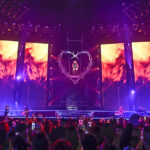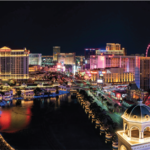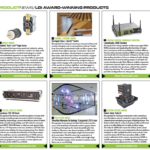
Four years off the road didn’t mean that Nine Inch Nails wasn’t busy. Along with a number of projects, the band nailed its induction into the Rock and Roll Hall of Fame in 2020. This year, they returned to hammer down a limited number of make-up headlining dates—from past pandemic cancellations—on their spring and fall 2022 tour. Also returning to handle the creative elements is Toss Film & Design Inc., a boutique design agency delivering diverse brand-oriented experiences. The company’s line is that they take pride in “offering scalable solutions from an internationally curated outreach to the entertainment industry’s most demanding artists using an environmental and ethical approach with a sustainable twist.” PLSN spoke with Toss Film & Design’s Paul “Arlo” Guthrie about his work as designer, director, and programmer for the NIN tour. We also checked in with Lighting Technician Matthew “Matt” Schiller for some fixture details in the design, with lighting supplied by tour vendor Upstaging.

‘Passion for the esoteric’
“I received a communiqué early in the year to alert the team at Toss Film & Design to shows that were being scheduled to make up for engagements that were previously made then cancelled in both 2020 and 2021,” Guthrie explains. “We endeavored to adapt and modernize the basis of the aesthetic from the previous Cold, Black and Infinite Tour with some upgrades and evolution but needed an adaptive yet resolute design to deal with the myriad of shows across the expansive territories and markets that were planned. Some passionate discussions ensued, and many permutations were explored and developed over the course of three arduous months.” The synergy that prevailed from these conversations had one thing in common: “a passion for the esoteric.”
Nine Inch Nails’ front man Trent Reznor and musician, record producer/composer and band member Atticus Ross both collaborated thoroughly throughout the creative process with the team. “They bring their keen artistic judgment, impeccable taste and insights to the journey with a commitment to the craft second to none,” Guthrie says. “Their contributions are both visionary and perpetually groundbreaking, melding intense industrial sensibilities with overt sexuality nestled neatly in a visceral puff pastry vol-au-vent of assault. At integration we immediately knew the audience would be transported to a never before imagined ecstatic level of stimuli and experiential enlightenment.”
To illuminate the path to that enlightenment, Guthrie specified a lighting rig with ACME products, specifically 27 Solar Impulse, 26 Gemini, and eight Thunder Breaker fixtures. He also pumped up the production with GLP, using 39 JDC1 Hybrid LED Strobes, and 32 impression X4 Bar 20. There are 45 Elation DARTZ 360 making up a big part of the rig, enhanced with five Elation CUEPIX Blinder WW4s. The 48 CHAUVET STRIKE 4 are arranged together in the downstage rig. And to acknowledge their penchant toward “anti-technology,” Guthrie added in 82 PAR64 fixtures to achieve a certain look behind the band. He is running the rig on an MA Lighting grandMA3 lighting console.
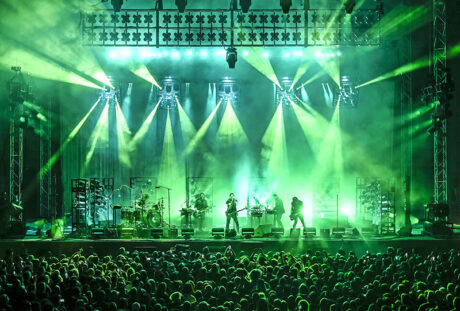
As a collective, Guthrie and the team wanted to present a combination of technologies as a homage to the past—such as with the PAR cans—with a calculated look forward to the future with the LED products to establish a symbiotic confluence. “The thrill of the heat emanating from the incandescent filaments provided a familiar and comforting base, similar to being enveloped in a warm childhood blanket which evoked a nostalgic atmosphere of color and temperature memory triggers,” he says. “Each different fixture type was systematically purpose-selected to deliver a particularly unique sensory response at the precise moment that matched its key shining properties and unique photon vibrational frequencies.”
He compares the products to an artist’s brushes and tools. “The automated instruments were all chosen to paint individualistic strokes on the canvas, and like oils, acrylics, gouache and charcoal, they all contributed unique texture layers combining harmoniously to graphically enhance each individual nuance of the musical landscape,” he explains. While he has used all of these fixture types on previous gigs, he says he viewed them in a new light. “I meticulously studied their intricacies and relished the challenge to deploy them in new and challenging ways to tailor their strengths and weaknesses to the challenges of the Nine Inch Nails.”
While one notices the absence of video screens or media content, it’s not really missed, Guthrie notes. “When we started this whole cycle of aesthetics, we used Trent’s intuition and sixth sense of knowing how his show will fit in with the world at large. At that time, everyone had a video visual component, and we wanted to be ‘the anti-that.’ So, we never bothered. We wanted to be on our singular path of anti-technology and didn’t want gratuitous visuals; additionally, we had 100 songs in the live catalog, so not having a video component meant there was one less thing to deal with when Trent wanted to change or add songs in the set. We had a different set list every single night, so a stealth approach was warranted to propagate the directive and the freedom it afforded us was intoxicating.”
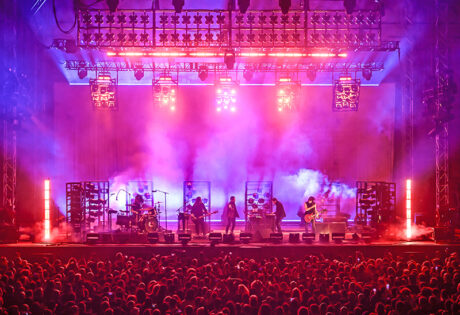
Instead, to play on the light and shadows motif, Guthrie brought in a backdrop to create textured shadow effects. “It was affectionately referred to as ‘the dirty diaper’—an expansive torn gauze, scenically-painted expression of our inner moods. It is designed to look disparagingly ugly and evokes the feeling of dragging a week-old bandage through cat litter. It was used upstage and utilized to throw shadows from the floor in a myriad of ways and techniques. An intriguingly unique look came from the ACME Gemini [a strobe and a zoom bar fixture] where single strobe diodes danced gingerly from stage extreme to stage extreme creating and thus animating a dizzying and towering shadow dance.”
Guthrie chose the Gemini fixtures for the shadow gag because of their double-sided feature. “I worked closely with Upstaging to develop the idea of a double-sided light that could have color on one side and zooming and a strobe tube on the other while having a strong link to astrology and the greater universe. The Gemini fit the bill perfectly,” he says. “Plus, they are low profile and sit elegantly along the downstage edge without breaking the all-important bond between performers and their audience. It was [Upstaging’s] John Huddleston who pitched the ACME Gemini as a ‘NINteresting’ choice of fixture before they had even purchased any, and his instincts were sharp. The shadow gag was one of the more visually striking moments and became an iconic signature look of the show.”
As far as other lighting fixtures are concerned, Guthrie states that because the band spends a lot of time in dark recording studios, it has become a large part of his responsibility to provide fixtures that encourage production of vitamin D3. “This helps the tour meet its rigorous scheduling demands and is key to optimum physical health for everyone on stage as well as thwarting the onset of osteoporosis,” he notes.
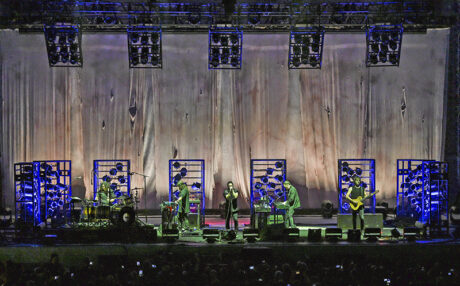
Lighting Tech
Lighting Technician Matthew “Matt” Schiller worked with Guthrie on his 2017 NIN tour, and also when the LD was designing Stevie Nicks’ tour a few years ago. “I enjoy working with Arlo. He is easy to work with and always has a good sense of humor,” Schiller says.
As it is his day-to-day job to keep the rig running—rather than worrying like Guthrie about how the fixtures are “contributing to production of vitamin D3”—Schiller describes what’s in the rig. Five pods in the upstage rig above the band are each loaded with nine Elation DARTZ 360, for a total of 45 automated luminaires, along with one ACME Thunder Breaker. The fixtures travel in the pods, and each Thunder Breaker is then placed on the outside top of the rig for a strobing effect in the show. The five pods of the Dartz 360 were positioned to hang almost at a 45˚ angle to give the beams a volumetric layered lighting look, much like nails.
Another grouping of eight square pods filled with PAR64s are positioned on wheels on the floor in a semi-circle behind the band. Constructed on each side of the stage is a small tower of six GLP JDC1 LED hybrid strobes stacked vertically to offer bright, flashing effects. On the ground between the pods are the ACME Solar Impulse fixtures. A downstage rig is populated with CHAUVET STRIKE 4 Arrays. “We call it the ‘Wall of Light,’” Schiller explains. Because the band doesn’t want to be lit with spotlights, Guthrie uses various other fixtures such as the CUEPIX Blinder WW4s. “There were blinders pointed back at the band, like a low front light.”
One thing that the design shares with the 2017 design is the prevalence of light and shadows. “There’s definitely some similarities in terms of a ton of light and fog everywhere and tons of strobes,” Schiller remarks. “It’s a bright show, but it’s cool and fun and doesn’t look like anything else out there. There is always something different with a Nine Inch Nails show.”
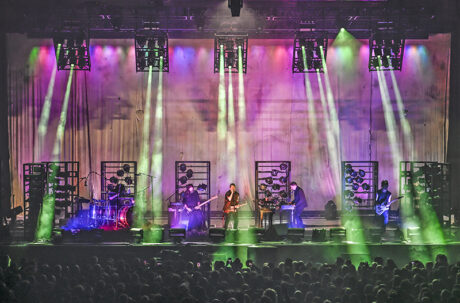
Accolades for Crew and Upstaging
Guthrie says they have been lucky to constantly have the support of world class vendors. “And this year, Upstaging upheld their stellar reputation as a company that deserves 50 years of enviable success and accolades,” he notes. “Both John Huddleston and Dan Curley provided endless emotional support and life coaching skills that I’ve carried beyond the tour as well as supplying us a plethora of gifted and talented crew, which have now become lifelong friends and an irreplaceable part of the Nine Inch Nails extended family.” And with a nod to their expert touring talents, Guthrie adds, with a wink, “It takes a certain animal instinct and deft physical prowess to elegantly handle a stubby PAR64 within inches of the eye of the storm while evading certain death or at the very least hideous disfigurement.”
Giving kudos to colleagues on the team, Guthrie credits Tour Manager Jerome Crooks, Production Manager Bill Rahmy, Road Manager Brett Bachemin and Production Coordinator Sonja Stevenson as being “industry legends and the height of consummate professionals unflappably remaining laser focused on the success of delivering the most demanding tour imaginable. I deferred to them on all decisions so I could leverage and glean their wisdom to guide my decisions and as a sounding board for artistic explorations and studies. Collaboration is always key and having such calm demeanors and their combined enviable wealth of experience on my side was a godsend when it came to how incredible this tour turned out considering all the challenges this touring cycle presented. Their management of all pre-production, production, post-production, logistics, pre-visualizations, visualizations, budgets, transportations, hotel bookings, playback, technical drawings, and off day activities was unparalleled.”
Production Team
- Lighting Designer, Programmer & Director: Paul “Arlo” Guthrie
- Lighting Crew Chief: Chris Coyle
- Lighting Techs: Adam “Kong” Morrison, Matt Schiller, Morgan Brownen
- Tour Manager: Jerome Crooks
- Production Manager: Bill Rahmy
- Production Coordinator: Sonja Stevenson
- Stage Manager: Allan Stewart
- Road Manager: Brett Bachemin
- Rigger: Ashlee Veghte
Vendors
- Lighting & Trucking: Upstaging/Reps. John Huddleston, Dan Curley
Gear
- 1 MA Lighting grandMA3 Lighting Console
- 27 ACME Solar Impulse
- 26 ACME Gemini
- 8 ACME Thunder Breaker
- 39 GLP JDC1 LED Hybrid Strobe
- 32 GLP impression X4 Bar 20
- 45 Elation DARTZ 360
- 5 Elation CUEPIX Blinder WW4
- 48 CHAUVET STRIKE 4
- 82 PAR64
- 8 Reel-FX DF-50 Hazer
- 4 High End Systems F-100 Performance Fog Generator
